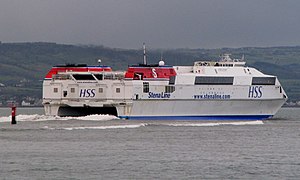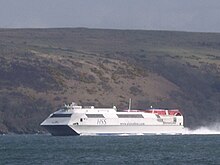HSC Stena Voyager
 Stena Voyager departing Belfast
| |
| History | |
|---|---|
| Name | Stena Voyager |
| Owner | Stena Recycling |
| Operator | N/A |
| Port of registry | London |
| Route | Belfast–Stranraer (GB) |
| Builder | Finnyards, Finland |
| Yard number | 405 |
| Laid down | May 1995 |
| Launched | 23 February 1996[1] |
| Completed | June 1996 |
| In service | June 1996–2011 |
| Identification | IMO number: 9080209 |
| Fate | Scrapped[2] |
| General characteristics | |
| Class and type | HSS 1500 |
| Tonnage | 19,638 GT |
| Length | 126.6 m (415 ft 4 in) |
| Beam | 40.0 m (131 ft 3 in) |
| Draught | 4.8 m (15 ft 9 in) |
| Installed power |
|
| Propulsion |
|
| Capacity |
|

Stena Voyager was a high-speed ferry owned by Stena Line which used to operate on their Belfast–Stranraer service. It was the second of three HSS 1500 class of high-speed ferries developed and introduced by Stena Line from 1996 onwards. The others were Stena Explorer and Stena Discovery.
In 2013, Stena Voyager was sold for scrap. It was towed to Landskrona, Sweden, where was broken up by Stena Recycling, another member of Stena Sphere.[2]
Design
[edit]The vessel was a catamaran, and was designed with the aim of providing a comfortable and fast service.[4] The sailing time between Belfast and Stranraer was 119 minutes.[5]
Power was provided by four GE Aviation gas turbines in a twin combined gas and gas (COGAG) configuration.[6][7] The vessel employed four Kamewa waterjets for propulsion.[6][8]
The HSS class of ferries were designed to allow quick turnarounds at port. A specially designed linkspan provided ropeless mooring and allowed quick loading, unloading and servicing. Vehicles were loaded via two of the four stern doors and parked in a "U" configuration. When disembarking, vehicles drove straight off via the other two doors.[9]
History
[edit]Construction
[edit]Stena Voyager was constructed by Finnyards in Rauma, Finland.[8][10] Construction commenced in May 1995 and was completed in June 1996,[8] before entering service in July 1996.[11]
Career
[edit]Stena Voyager spent the majority of her career sailing on her original route between Belfast and Stranraer, apart from short periods covering for her sister ships.[11]
Incidents
[edit]On 28 January 2009, a lorry carrying ferrous sulphate powder burst through the stern doors of the Stena Voyager shortly after departure. Because of this, the ferry had to return to Stranraer. Subsequent sailings were postponed.[12] The cause of the accident was the driver of the lorry failing to park it in gear and to apply the handbrake. The vehicle was insufficiently secured to the ship's deck.[13]
Uncertain future
[edit]During 2010, Stena Line was beginning the process of transfer operations from Stranraer Port to a new port facility at Cairnryan, five miles further north up Loch Ryan. The new port at Old Light House Point was to be called Loch Ryan Port. Planning application materials submitted in 2008 stated that a pair of new conventional Ropax ferries operating at 21–24 knots (39–44 km/h; 24–28 mph) would take over all operations on the service, replacing the operations of Stena Voyager and the conventional ferry MS Stena Caledonia. The new pair of vessels would provide a passage time of 2 hours between Scotland and Belfast and be fitted out with "passenger facilities similar to an HSS".[14] No HSS-compatible linkspan was planned to be provided at the new port.[15]
In March 2011, Stena Line announced the Stena Voyager and her running partners on the Belfast – Stranraer route (Stena Caledonia and Stena Navigator) were to be replaced in Autumn 2011 by the Stena Superfast VII and Stena Superfast VIII chartered from Estonian ferry operator Tallink.[16] Stena Voyager was widthdrawn from service on 20 November 2011 and was laid up in Belfast until 2013.
Scrapping
[edit]In April 2013, it was reported that Stena Voyager had been sold for scrapping. She was towed to Landskrona, Sweden, where the vessel was broken up by Stena Recycling.[2]
In media
[edit]In 2009, Stena Voyager appeared in the BBC television series Top Gear. Jeremy Clarkson, ostensibly having missed the ferry, tried to leapfrog a Renault Twingo on the departing Stena Voyager. The car sank into the wash behind the departing ferry.[17] Actor Ross Kemp was supposedly locked in the boot of the car that Clarkson was seen driving.
See also
[edit]References
[edit]- ^ "Stena Voyager (9080209)". Miramar Ship Index. Retrieved 12 September 2020.
- ^ a b c d Stena-katamaran till återvinning. Sjöfarts Tidningen, 29 April 2013. Retrieved 2013-05-04.
- ^ Bowen, David (4 May 1996). "Forget the tunnel; all the talk on the high seas is of 50mph super ferries. And Britain doesn't make any of them". Independent. London. Retrieved 29 January 2016.
- ^ "The story behind the building of the first Stena HSS". Dun Laoghaire Harbour Company. Archived from the original on 8 December 2009. Retrieved 26 December 2009.
- ^ "Our Ships: Stena Voyager". Stena Line. Retrieved 26 December 2009.
- ^ a b MacLennan, Graeme (15 December 1993). "Powerful propulsion for Stena catamaran ferry". Lloyd's List. United Kingdom: 6. ISSN 0144-820X. Archived from the original on 27 January 2013. Retrieved 26 December 2009.
The HSS will be propelled by four KaMeWa equal-sized waterjets (two in each hull, and all with steering and reversing heads). These were to be powered by two father-and-son configurations comprised in each case of a Kvaerner-General Electric LM2500 and LM1600 gas turbine, driven through Maag combining and splitting gears.
- ^ "GE Marine Engines' LM Gas Turbines Exceed 600,000 Hours Operating Aboard 16 Fast Ferries". GE Aviation (Press release). 9 September 2002. Archived from the original on 11 December 2010. Retrieved 26 December 2009.
Each semi-swath fast ferry has two LM1600 and two LM2500 gas turbines in a Combined Gas and Gas (COGAG) turbine configuration.
- ^ a b c "Stena Voyager". DNV Exchange. Det Norske Veritas. Retrieved 26 December 2009.
- ^ King, Mike (28 May 2003). "Ro-Ro: A question of size rather than speed". Lloyd's List. United Kingdom: 16. ISSN 0144-820X. Archived from the original on 27 January 2013. Retrieved 26 December 2009.
The HSS concept allows simultaneous discharge and loading through all four sterndoors. Car lanes are located as close as possible to the ship and arranged into four lanes to speed turnround. The linkspan mooring arrangement removes the need for ropes, and passengers, stores, fuel and water are all loaded at the same time, typically cutting loading or unloading times to 10-15 minutes.
- ^ Mott, David (11 May 1994). "Stena orders fast ferry". Lloyd's List. United Kingdom: 18. ISSN 0144-820X. Archived from the original on 27 January 2013. Retrieved 26 December 2009.
The order for the 1,500-passenger, 40-knot vessel has gone to Finnyards in Rauma, the yard which won the first two craft, for Stena Sealink last summer.
- ^ a b "Stena Voyager". Fakta Om Fartyg (in Swedish). Retrieved 26 December 2009.
- ^ "Lorry found hanging out of ferry". BBC News Online. 29 January 2009. Retrieved 26 December 2009.
... returned to Stranraer in Scotland after a lorry was discovered hanging out the back of the Stena Voyager. The vessel was not long at sea when a loud bang was heard by passengers.
- ^ "Report on the investigation of the shift of an articulated road tanker on board the roll-on roll-off high-speed sea service cargo ferry Stena Voyager in Loch Ryan on 28 January 2009" (PDF). Marine Accidents Investigation Branch. Retrieved 26 December 2009.
- ^ Davison, Alistair; Environmental Resources Management Limited (9 December 2008). 2.5.3 Operation (PDF). Loch Ryan Port. Vol. Environmental Statement. Edinburgh: Stena Line. p. 18. Retrieved 3 February 2010.
two modern RoPax vessels which will replace the HSS (Stena Voyager) and the conventional ferry (Stena Caledonia) which currently operate on the route. ... following characteristics. Speed – 21 - 24 knots ... Passenger facilities similar to an HSS ... daytime crossings of around 2 hours
{{cite book}}:|work=ignored (help) - ^ Morton, Robin (2 June 2009). "Future of Stena's HSS ferry service on the line". Belfast Telegraph. Retrieved 3 February 2010.
no provision has been made for HSS docking facilities at a proposed new £70m ferry terminal due to open in 2011 at Loch Ryan Port
- ^ "New ships for Scotland - NI service". Stena Line. 7 March 2011.
- ^ "Top Gear's ferry daring stunt". Belfast Telegraph. 6 October 2009. Retrieved 19 October 2009.
Top Gear were in Northern Ireland yesterday for their latest madcap stunt — firing a car at the Stena HSS in Belfast
